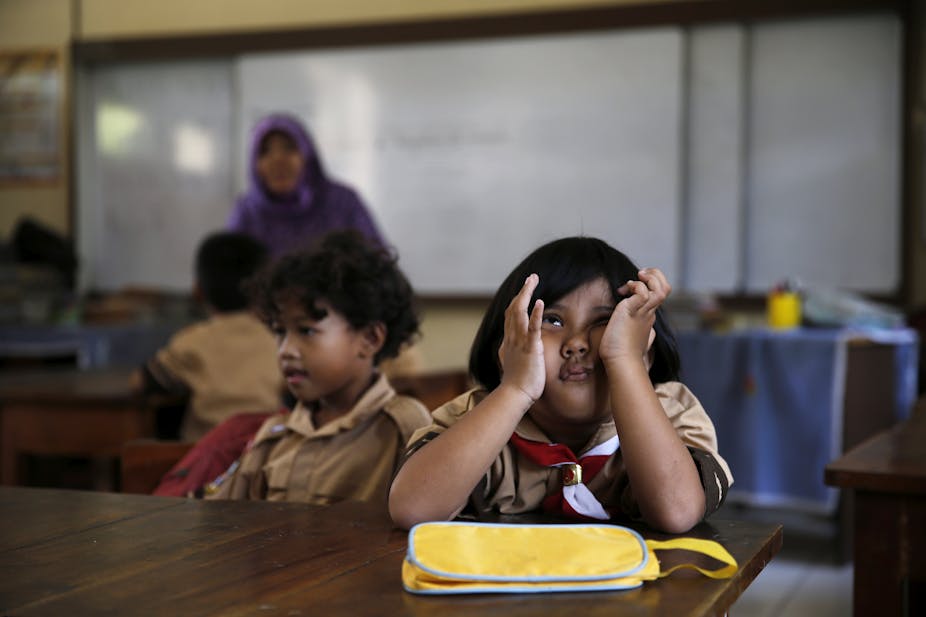Schools in Indonesia often make students feel stressed and tired, draining them of motivation. A group of Indonesian scholars, which I lead, is creating a movement to make schools in Indonesia a fun place to learn, in collaboration with primary school teachers from Australia.
We named our initiative the Fun School Movement. We have been working with Clayton North Primary School, a state school in Victoria. They sent five teachers to Indonesia to share whole-school teaching methods with 40 teachers and 30 pre-service teachers for elementary schools in Yogyakarta in 2014 and 2015.
With the support of the University of Ahmad Dahlan, we facilitated workshops. Teachers in Indonesia can learn from Australian teachers’ experience to develop a new approach that provides a joyful and positive learning environment for students.
Currently, some schools in Magelang and Klaten in Central Java, Aceh and Bandung are interested in joining the movement because they are attracted by the bottom-up approach we provided for the teacher capacity building.
Australia’s fun primary education
I was inspired to start this movement after seeing how the Australian education system worked through my daughters’ experiences.
In 2009, I moved to Melbourne with my family for my PhD at Monash University. I enrolled my children in Clayton North Primary School.
Every time I pick up my children they are happy and keen to tell me what they had done at school. They even like to go to the school during the weekends.
In contrast, when they went to school in Indonesia they were tired and overwhelmed by the amount of work they had to do in each subject.
Children in Indonesian schools have a mountain of homework. Many parents have to help children complete their homework for hours because they worry the children cannot complete all the tasks.
Schools in Indonesia focus on transferring as much knowledge as possible, even when the materials may not be relevant to students’ needs and their developmental stage.
The Indonesian government had attempted to reduce the overload of materials in 2013. The government introduced a new curriculum that integrated subjects into a theme and promoted character building and creativity.
But this approach failed as many teachers were not ready to implement the new curriculum due to lack of skills. Character building and creativity were also taught only in theory and assessed in a final test. The curriculum has since been terminated by Indonesia’s minister of education and culture, Anies Baswedan.
I found a different teaching style and school model in Australia. Schooling in Australia is based on a framework designed by the Australian Curriculum Assessment and Reporting Authority (ACARA), a federal educational body.
ACARA requires schools throughout Australia to make children happy, healthy and feel empowered to contribute to the society. Schools strive to ensure every child has a positive learning environment.

I want to see more Indonesian children having a joyful school experience.
Happy students
Australian students are not the best performers in PISA, the global tests that assess 15-year-old students in maths, science and reading. But Australian students rank high on educational wellbeing compared to OECD countries. Australia ranks higher than the UK and US, as well as Germany and France.
For PISA, Australia has performed equal 10th in reading, equal 8th in science and equal 17th in mathematics. These results saw Australian students’ rankings slipping from previous years. But they still did better than average compared to students from other OECD countries.
With all the stress and pressure students in Indonesia face, they performed much worse in the PISA tests. Students from Indonesia scored the second-lowest out of 65 countries.
Some experts doubt if PISA is a good standard to test quality of education in countries. They argue PISA results are not a reflection of education policies in countries.
Experts argue that student wellbeing has significant impacts on students’ learning habits, motivation and positive outlook or behaviour, as this study shows.
School life at Clayton North
At Clayton North, my children were welcomed and included as new students. The school has a “buddy program” to help new (junior) students feel safe, valued and connected to the school community.
Clayton North also engages parents to support children’s learning. The school runs a program called “reading together”, where parents are invited to assist children to read in class every day before the class begins.
To build respect in diversity, Clayton North has a “harmony day”. All members of the school community come on that day to celebrate and represent their heritage.
The school uses KidsMatter, a flexible program that uses a whole-school approach to promote mental health and wellbeing for children. The school has a “creative play space”, where children can express their ideas and make something new. They are supervised to work together to learn and practise real-world learning. This effectively helps them in building social and emotional wellbeing.
Indonesia’s students’ park (Taman Siswa)
The Australian primary education system’s emphasis on creating joyful and inclusive schools is similar to what Indonesia’s father of modern Indonesian education, Ki Hadjar Dewantoro, suggested.
In 1922, Dewantoro set up an inclusive school called “Taman Siswa”, or students’ park. This was during the Dutch colonial rule and formal education was available only for the Dutch and local royalties. In Taman Siswa, children of ordinary people could enrol and were given a joyful and stimulating environment.
Dewantoro later became Indonesia’s first education minister. According to Dewantoro, schools should be a fun place.
Unfortunately, it’s difficult to find Taman-like schools today that make learning a fun activity in Indonesia.
By collaborating with teachers from Australia, I want to bring “Taman” back to Indonesian children.

